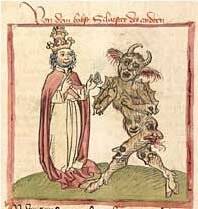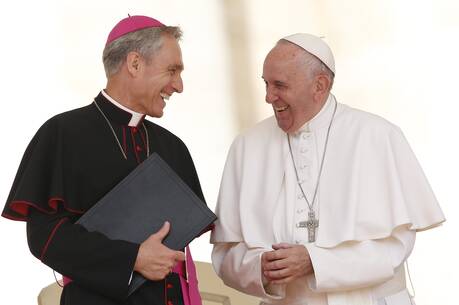The Italians have an indispensible saying. Se non è vero, è ben trovato. “If it’s not true, it’s well found.” That’s how they suggest that it’s possible to miss the thrust of a truth by fretting excessively about its historical foundation. Put another way, some stories are too good not to be true, and, since we can never fully prove their veracity, we might as well learn from them what we can. That’s how I’d introduce this spooky story about the Basilica of Saint John Lateran in Rome.
We’ve already stood outside, on the Lateran Hill, named after the noble Roman family, which donated this land under the Emperor Constantine. We’ve admired the palatial, renaissance façade of the church.
Coming into the church, almost as large as Saint Peter’s, we’ve looked back, above the doors which we entered. There we saw the words: Sacrosancta Lateranensis ecclesia omnium urbis et orbis ecclesiarum mater et caput (“Most Holy Lateran Church, of all the churches in the city and the world, the mother and head”). Yes, this is the cathedral church of Rome. More popes have been buried here than at Saint Peter’s. Bernini’s Twelve Apostles flank the long nave. They’re a bit too large for their niches, but that only seems to add to their stature. The nave’s coffered ceiling is overlaid in gold, brought here from the new world.
But we leave the central nave and go into the right side aisle, in order to visit the tomb of Pope Sylvester II, who reigned from 999 to 1003. It’s not actually a tomb. It’s a cenotaph, a memorial monument. The Church of Saint John Lateran burned twice in the 14th century, which meant that many of its papal bones had to be reinterred. I point out water stains on the monument, ask you to touch them and tell me if they now moist. Then I share this story, the one so well found.
Gerbert d'Aurillac, the man who became Pope Sylvester II, is said to have practiced black magic. (It’s more likely that he was a nascent scientist before his time, but on with the story.) Gerbert is said to have gained the papacy through dark sorcery. He was promised that the papal throne would be his, “until he died in Jerusalem.” That seemed a sweet deal, given that the city, where our Lord had suffered and died, had been under Muslim control for several centuries. Small chance of a pope visiting Palestine.
Here’s the first chilling twist. Pope Sylvester breathed his last while saying Mass, right next door to Saint John Lateran, in the Church of the Holy Cross of Jerusalem. You see, it contains dirt from Jerusalem, brought to Rome under Constantine. And so, the Vicar of Christ, seeing the collapse of his bargain and knowing that he was about to summoned for an account of his stewardship, confessed his sin of sorcery to the papal entourage.
He knew, he said, that he was unworthy to be buried in consecrated ground, so he told them that, following his obsequies in the Church of Saint John Lateran, his bier should be placed in horse-drawn hearse. The riderless horses having been whipped into movement, the entourage should follow them and bury Pope Sylvester wherever the cortege came to a stop.
That’s what they did. The horse-drawn carriage slowly left the steps of Saint John Lateran. A pensive crowd followed it through the city’s nearby gates. The carriage made a large circle, and then reentered the same gates, coming to rest before the doors of the Lateran Basilica. Everyone took it as a sign that the sorcerer pope had been forgiven.
Yet even today, the tomb is said to weep when a pope is about to die. You can clearly see the water stains. Let’s hope the marble is dry, though it’s always cool and seems, ever so slightly, moist.
Why share such a story on the feast of this church’s dedication? Se non è vero, è ben trovato. If it’s not true, why is it so well found?
First, because this feast is not about the stones of the Lateran, but about the rock on which Christ founded his Church. This is the cathedral church of Rome, “the mother and head of all the churches in the city and the world.” This is where the Bishop of Rome has his cathedra, the teaching seat from which he leads the church. We praise God on this day, because we have a visible means of unity, a person and a place, under which all Christians can gather, despite their very different experiences of life and distinctive understandings of the Gospel.
Second, because the spooky story centers upon the mission of Christ’s vicar. That’s what counts with any pope. Not his sanctity, his intellect or his talents. Hopefully these are not lacking, but they are not the cause of our confidence. Good popes can draw multitudes to Christ, but all popes are instruments and signs of solidarity. They remind us to reverence the unity of the church, a wholeness for which Christ himself prayed the night before he died.
And finally, although it is quite true to say that, in this very moment everything depends upon our own fidelity to the faith, our own embrace of baptismal mission, in the Catholic Church, this particular moment is never isolated in time. It is always suffused with the weight, and the wisdom, of 20 some Christian centuries.
They say that Pope Sylvester’s body was perfectly intact when it was exhumed in 1684, though it immediately turned to dust in contact with the air. Perhaps he was much holier than people thought. Who knows? Se non è vero, è ben trovato. What we do know is that this “Mother Church” doesn’t simply call cities, countries, and continents to herself. She calls the centuries as well.
Ezekiel 47: 1-2, 8-9, 12 1 Corinthians 3: 9c-11, 15-17 John 2: 13-22








